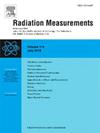掺pr Lu2.5Y0.5(Al2.5Ga2.5)O12单晶的发光和闪烁特性
IF 2.2
3区 物理与天体物理
Q2 NUCLEAR SCIENCE & TECHNOLOGY
引用次数: 0
摘要
本文采用悬浮区法合成了掺杂浓度分别为0.5、1、2和4mol % Pr3+的Lu2.5Y0.5(Al2.5Ga2.5)O12 (LuYAGG)石榴石单晶,拉伸速率为4mm /h。这些晶体在可见光范围内具有较高的透光率(85% ~ 95%),在278 nm附近发现了Pr3+的吸收特征,对应于4f-5d1跃迁。在300 ~ 430 nm (5d1-4f跃迁)和430 ~ 680 nm (4f-4f跃迁)之间观察到光致发光(PL)发射,如PL等高线图所示。在x射线激发下,辐射发光(RL)光谱在290 ~ 450 nm和450 ~ 680 nm范围内显示出较宽的发射,分别与5d1 ~ 4f和4f ~ 4f跃迁相一致。在所有测试成分中,掺杂2mol % Pr3+的样品在662 keV γ射线激发下显示出最佳的闪烁产光率,约为20,000光子/MeV,能量分辨率为24.6%。所有样品的PL衰减时间常数都在几十纳秒的范围内。本文章由计算机程序翻译,如有差异,请以英文原文为准。
Luminescence and scintillation characteristics of Pr-doped Lu2.5Y0.5(Al2.5Ga2.5)O12 single crystals
In this work, Lu2.5Y0.5(Al2.5Ga2.5)O12 (LuYAGG) garnet single crystals doped with Pr3+ at concentrations of 0.5, 1, 2, and 4 mol% were synthesized using the floating-zone method with a pulling rate of 4 mm/h. These crystals displayed high transmittance in the visible range (85 %–95 %), and Pr3+ absorption features were identified near 278 nm, corresponding to the 4f-5d1 transition. Photoluminescence (PL) emissions were observed between 300 and 430 nm (5d1-4f transition) and 430–680 nm (4f-4f transition), as illustrated by PL contour mapping. Under X-ray excitation, radioluminescence (RL) spectra showed broad emissions in the 290–450 nm and 450–680 nm ranges, consistent with 5d1-4f and 4f-4f transitions, respectively. Among all tested compositions, the sample doped with 2 mol% Pr3+ demonstrated the best scintillation light yield, approximately 20,000 photons/MeV when excited by 662 keV γ-rays, and achieved an energy resolution of 24.6 %. The PL decay time constants for all samples were within the range of several tens of nanoseconds.
求助全文
通过发布文献求助,成功后即可免费获取论文全文。
去求助
来源期刊

Radiation Measurements
工程技术-核科学技术
CiteScore
4.10
自引率
20.00%
发文量
116
审稿时长
48 days
期刊介绍:
The journal seeks to publish papers that present advances in the following areas: spontaneous and stimulated luminescence (including scintillating materials, thermoluminescence, and optically stimulated luminescence); electron spin resonance of natural and synthetic materials; the physics, design and performance of radiation measurements (including computational modelling such as electronic transport simulations); the novel basic aspects of radiation measurement in medical physics. Studies of energy-transfer phenomena, track physics and microdosimetry are also of interest to the journal.
Applications relevant to the journal, particularly where they present novel detection techniques, novel analytical approaches or novel materials, include: personal dosimetry (including dosimetric quantities, active/electronic and passive monitoring techniques for photon, neutron and charged-particle exposures); environmental dosimetry (including methodological advances and predictive models related to radon, but generally excluding local survey results of radon where the main aim is to establish the radiation risk to populations); cosmic and high-energy radiation measurements (including dosimetry, space radiation effects, and single event upsets); dosimetry-based archaeological and Quaternary dating; dosimetry-based approaches to thermochronometry; accident and retrospective dosimetry (including activation detectors), and dosimetry and measurements related to medical applications.
 求助内容:
求助内容: 应助结果提醒方式:
应助结果提醒方式:


